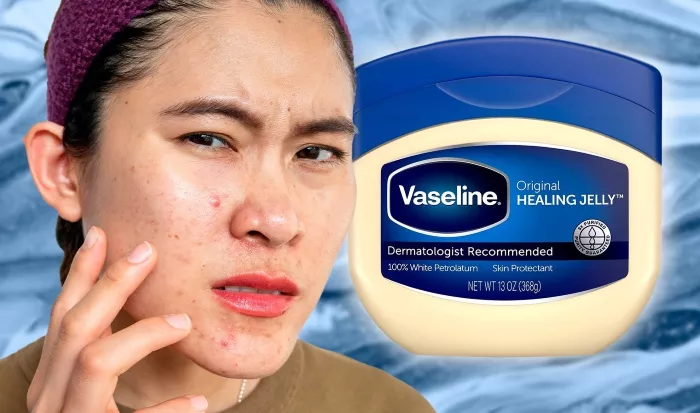Scars tell stories of our past injuries, surgeries, or acne battles. While some wear them proudly, many search for ways to fade these visible reminders. One of the most common questions dermatologists hear is: Can Vaseline remove scars? The truth is more nuanced than a simple yes or no. Let’s dive deep into how Vaseline interacts with scar tissue and what realistic expectations you should have.
Understanding Vaseline: What Exactly Is Petroleum Jelly?
Vaseline, the brand name for petroleum jelly, has been a skincare staple since 1870. This semi-solid mixture of hydrocarbons comes from petroleum refining. Unlike many modern skincare products filled with active ingredients, Vaseline’s power lies in its simplicity.
How Vaseline Works on Skin
When applied, Vaseline creates an occlusive barrier that:
- Locks in existing moisture (but doesn’t add moisture itself)
- Protects from irritants like bacteria and pollutants
- Creates an ideal healing environment by maintaining hydration
This unique mechanism makes it valuable for wound care, but its effects on established scars are different.
The Science Behind Scars: Why They Form and Persist
To understand if Vaseline can help, we must first understand scars. When skin is injured beyond the superficial layer, the body forms collagen fibers to repair the damage. This repair process often leaves behind:
- Discoloration (red, white, or darker than surrounding skin)
- Texture changes (raised, depressed, or uneven surfaces)
- Reduced function (less sweat glands and hair follicles)
Types of Scars Vaseline Might Help
Hypertrophic Scars
- Raised but stay within injury boundaries
- Often red and firm
- May benefit from moisture retention
Atrophic Scars
- Sunken or pitted appearance
- Common with acne or chickenpox
- Vaseline can improve surface texture
Post-Surgical Scars
- Linear marks from incisions
- Best addressed early in healing
How Vaseline Affects Scars: The Detailed Process
Moisturization Mechanism
Vaseline’s primary benefit comes from preventing transepidermal water loss (TEWL). By keeping the scar hydrated:
- Scabs form less (allowing better healing underneath)
- Itching reduces (preventing scratching that worsens scars)
- Skin flexibility improves (making scars less noticeable)
Limitations to Understand
While helpful, Vaseline:
- Doesn’t contain collagen-boosting ingredients
- Can’t break down existing scar tissue
- Doesn’t affect melanin production (for color correction)
Step-by-Step Guide: Using Vaseline for Scars Effectively
1. Preparation Stage
Cleanse the area
- Use lukewarm water and mild soap
- Pat dry gently (no rubbing)
Assess scar maturity
- Fresh scars (pink/red) respond best
- Older scars may need additional treatments
2. Application Technique
Scoop a pea-sized amount
Too much can clog pores
Warm between fingers
Makes application easier
Massage gently in circular motions
- Promotes absorption
- May help with collagen alignment
Timing matters
- Best applied after showering
- Reapply 2-3 times daily for fresh scars
3. Enhancing Results
Combine with:
- Sunscreen (UV protection prevents darkening)
- Silicon sheets (for raised scars)
- Light massage (improves blood flow)
Timeline: What to Expect Week by Week
First 2 Weeks
- Reduced dryness and flaking
- Less noticeable scabbing
1-3 Months
- Improved texture
- Subtle fading of discoloration
6+ Months
- Maximum results visible
- Further improvement unlikely without additional treatments
Expert Tips for Maximizing Results
Start Early
Begin application once wound is closed
Be Consistent
Daily use yields best results
Manage Expectations
- Complete removal is unrealistic
- Focus on improvement, not perfection
Combine Approaches
- Use with sun protection
- Consider microneedling for old scars
When Vaseline Isn’t Enough: Signs You Need Professional Help
Consult a dermatologist if you notice:
- Increasing pain or itching
- Scar continues growing
- Significant functional impairment
- No improvement after 6 months
Preventative Use: How Vaseline Can Help Avoid Scars
Using Vaseline properly during wound healing can:
- Reduce scab formation by 40%
- Decrease likelihood of noticeable scarring
- Shorten overall healing time
Proper Wound Care Protocol
- Cleanse with saline
- Apply antibiotic ointment (first 3 days)
- Switch to Vaseline once risk of infection passes
- Keep covered initially, then allow to breathe
Conclusion
Vaseline plays a valuable role in scar management by keeping the skin hydrated, reducing itchiness, and creating an optimal healing environment. While it can help improve the appearance of fresh scars by preventing excessive dryness and scabbing, it does not actively break down old scars or alter pigmentation.
For the best results, Vaseline should be used consistently and combined with other treatments like sun protection, silicone sheets, or professional dermatological procedures for stubborn scars. Managing expectations is key—while Vaseline can aid in softening and smoothing scars, complete removal is unlikely. If scars show no improvement or cause discomfort, consulting a dermatologist is the best course of action.
Frequently Asked Questions
Can I use Vaseline on my face for acne scars?
Yes, but ensure pores are clean first to prevent breakouts.
Is there a difference between generic and brand-name petroleum jelly?
In purity, no—but some find Vaseline’s texture easier to work with.
How long should I continue using it?
For optimal results, continue for 6-12 months post-injury.
Related topics:
Can microdermabrasion remove acne scars?
Can Plastic Surgeons Remove Scars?
Does Laser Freckle Removal Leave Scars?


